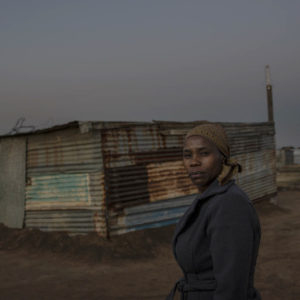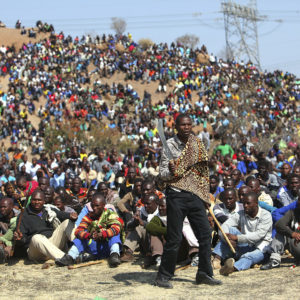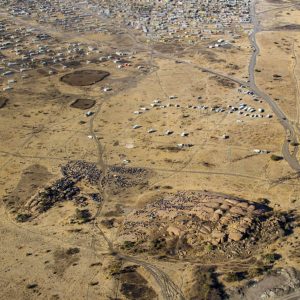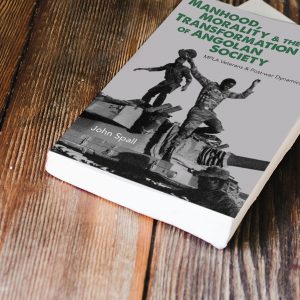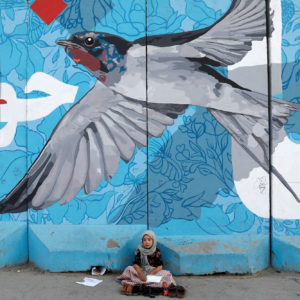Long Read | Sol Plaatje’s diary 120 years later
A rereading of the author and journalist’s work written during the siege of Mafeking brings home the abiding impact of his words and the sensibilities that informed them.
Author:
8 September 2021

How does one cope with incoming artillery shells sufficient to vaporise a horse or crush human skulls and mangle bodies into bits of flesh, all against the incessant rattle of enemy rifle fire from not much more than a mile away?
How do you deal with this, on a sustained 217-day basis, while managing to write – brilliantly – about this hell on earth?
So enraptured was I a few years back by Sol Plaatje’s extraordinary record of the Mafeking siege that I wanted to read it where he wrote it. I also wanted to evaluate his account against the precepts of literary or narrative journalism. This is a relatively recent area of scholarship: how well do Plaatje’s words, written 120 years ago, stack up?

This is a high bar. Plaatje was just 23 when he authored his diary, had no tertiary education and was yet to begin his extraordinary writing career.
He apparently did not even intend his siege diary for publication. He did not speak of it and its existence was not known even to close family and friends. It was discovered by researcher John Comaroff who, in 1969, asked the family if there were any old letters or papers in their possession. This was 70 years after Plaatje wrote the diary and 32 years after his death.
Comaroff describes the find in The Mafeking Diary of Sol T Plaatje (1973), which he co-edited. Handed a tatty leather scrapbook by Victor Molema, a grandson of Plaatje’s, Comaroff tapped its end against a table to remove the fine dust that permeated every surface: “As I did so, probably more vigorously than I ought to, some sheets of foolscap slid from under the back cover … the paper was brittle and yellowed with age. But the script – including, astonishingly, long passages in pencil – was almost entirely legible.”
The original, hand-written diary is now at the University of the Witwatersrand.

Plaatje’s writing casts a long shadow across the South African literary landscape, including his career as a newspaper editor, author of the epochal Native Life in South Africa (1916), the novel Mhudi (1930), and his translations of Shakespeare into Setswana and compilation of a Setswana dictionary. This is not to mention his position in 1912 as the first general secretary of the South African National Native Congress, which later morphed into the ANC.
Plaatje’s story has been impressively told by Brian Willan in his 710-page monument, Sol Plaatje: A life of Solomon Tshekisho Plaatje, 1876-1932 (2018).
On the cusp
Educated at the mission school at Pniel near Kimberley, Plaatje got his first job at the age of 17 as a postman in Kimberley. But his linguistic skill – he could speak and write seven languages – and competence in shorthand and on the new-fangled typewriter, saw him secure the position as clerk and court interpreter 360km north, at Mafeking.
He started the new job on 14 October 1898. Two days earlier, the Boers had ambushed the armoured train Mosquito at Kraaipan 60km down the track after the gold-rich Transvaal and Free State declared war the previous day. Two African railway workers, their names not recorded, were killed. The mighty British Empire was at war with the two upstart Boer republics.
Related article:
A 217-day siege began at Mafeking, the Boers pulling in their big artillery, including one of four Creusot 94-pound cannons, the most advanced piece of military hardware of the day, which they used to bombard the town relentlessly.
Not that on the face of it there was much to fight about. Thomas Pakenham in The Boer War (1979) described the town as on the “borders of nowhere: a railway siding … an oasis of tin roofs and mud walls in the sandy wastes where the Cape Colony, the Bechuanaland Protectorate and the Transvaal all touched fingers on the flank of the Kalahari Desert”.
I was warned that the town is run down. My expectations were not too high: the province had Supra Mahumapelo as premier from 2014 to 2018, when he stepped down following violent protests and many residents calling for his removal. But Mahikeng, as it is now named, largely conformed to a frontier town: busy, bustling, even though coronavirus restrictions had not been completely lifted.

A place of rocks
Mafeking is a corruption of Mahikeng, a place of rocks, as the Setswana-speaking Barolong called it. This is the original settlement on the banks of the Molopo River. In Plaatje’s time, as today, it was known as the stadt. Rocks of all sizes abound, many too large to be moved. Those of manageable size have been formed into walls, both straight and circular, to kraal animals and mark property boundaries.
One house was more prominent than the others. This, still in the Molema family, was home to Silas Molema, who took the young Plaatje under his wing and found him the job as clerk and interpreter. Plaatje lived in the house at times during the siege and the diary was found there.

Mahikeng may be named after a place of rocks, but today it is a place of litter: plastic lies draped on its streets and public places. The residential areas, though, are neat, even the yards of modest homes being swept and tidy. Private cleanliness, public mess.
Plaatje lived in the stadt during the siege and worked at the Civil Commissioner’s Office in the town, over the railway line, about a kilometre away. The Barolong had opted to side with the British against the Boers and were to play a decisive role in the defence of Mafeking. A line of fortifications a few kilometres out surrounded the town, the Boer positions being some kilometres further out, all within sniper range of one another.
My interest was to focus on how the siege diary stacks up against the tenets of what some scholars call literary journalism, also narrative non-fiction, a style of storytelling which presents factual stories using techniques more usually associated with fiction writing.
Related article:
Writers draw on their imagination and writing technique to tell the story. Often associated with long form, such narrative writing requires that the writer be immersed in the story, soaking the text in details of place, scenes, characters and the spoken word.
This approach, also coined the New Journalism, was outlined by Tom Wolfe in the 1970s and is associated with American feature writers of the period. But not all agree that the form emerged with Wolfe and Co and that its practitioners are uniquely American. The telling of factual stories using the full suite of writing techniques has a much longer history and a far wider dispersion than described by Wolfe.
In this vein, Andrew Griffiths has profiled George Warrington Steevens in the journal Literary Journalism Studies, making the case that Steevens, the pre-eminent British war correspondent of his era, wrote newspaper articles that read like short stories. Griffiths sees Steevens as typifying the highly commercial, personal and sensational British “new” journalism of the last quarter of the 19th century.
Drawing comparisons
Steevens, like Plaatje, was under siege during the Boer War, although not in Mafeking but Ladysmith – where he died of dysentery. It would be instructive, I thought, even though Steevens then was on top of his game while Plaatje’s published career was yet to begin, to compare the two.
I asked Sabata Mokae, who teaches creative writing at the Sol Plaatje University in Kimberley and who co-edited books with Willan on Plaatje’s novel Mhudi and his letters, whether he thought Plaatje’s siege diary measured up to the prescripts of literary journalism.
“I’m sure Sol Plaatje will pass the test. But keep in mind that the diary was his first major work, which he didn’t even intend to have published. It was also written at the time when he was only getting exposed to journalists and their work. So one could say Plaatje was quite courageous to undertake such a task as writing a war diary.”
Related article:
Plaatje’s first entry was on 29 October. His opening line sets up his relationship with the protagonist that was to define life under siege in Mafeking – the 94-pound Creuset cannon that he calls Au Sanna: “Haikonna [No] terror; and I have therefore got ample opportunity to sit down and think before I jot down anything about my experience of the past week. I have discovered nearly everything about war and find that artillery in war is of no use.
“I can say: no music is as thrilling and as immensely captivating as to listen to the firing of the guns on your own side. It is like enjoying supernatural melodies in a paradise to hear one or two shots fired off the armoured train; but no words can suitably depict the fascination of the music produced by the action of a Maxim, which to Boer ears, I am sure, is an exasperating grillery which not only disturbs the ear but also disorganises the free circulation of the listener’s blood.”
But while he mocks Au Sanna, there is also no denying the destruction it brought: “Got up this morning and found very lovely weather. Sanna started at 7.00 and sent three shells into the town. I got there at 9.00 and met Sgt Stuart who told me that the second shell burst in the Civil Commissioner’s stable and smashed the stable, Whiskey [Plaatje’s pony] and all – poor fellow. When I got there I only saw his blood and nothing more of him, and a good thing too.”
Plaatje tells of a group of 22 Fingoes [Mfengu, who had moved in from the southeast] who went to an area known as the Brickfields. They took shelter and killed several Boers, who responded with one of their seven-pound guns, which they “cocked it right into the kilns”.

A visceral view
“Our men lay flat against the bricks, seven-pounder shells crashing among them with the liberty of the elements. They went for the bricks, knocked spots out of the ground they lay on, and shattered the woodworks of their rifles between and alongside them; in fact they wrecked everything except the flesh of human beings.
“It affused several of its mortal discharges over them and when convinced that everyone was dead, it cleared away leaving the 22 men quite sound, but so badly armed that if the Boers had the courage to come near they would have led them away by the hands.”
Immersion and characterisation are often seen as two of the building blocks of good non-fiction storytelling.
Plaatje was immersed in his story, if involuntarily. He tells us enough about himself and life under siege for us to engage with his fears and concerns, he being one of the two principal characters in the drama. Who is the other? You may now, over a century later, have expected Colonel Robert Baden-Powell, the military boss of Mafeking, to be the other. But Baden-Powell hardly features.

Plaatje can’t characterise the enemy, the Boers or their leaders – Piet Cronje and, later, JP Snyman – as they are invisible to him.
So he makes Au Sanna the central character of the drama, putting the cannon front and centre, and imbuing it, as well as her progeny – shells and ordinance – with life and agency: “Pleasant soft rains all day today . . . I have never had a shell burst near me, but this afternoon while I was at the residency one of them exploded somewhere near to the east. A fragment came along, found its way through the roof, across the ceiling, hit the opposite wall and dropped onto the floor.
“This was in one of the rooms, but I thought that the whole house was coming down on me and I could already picture to myself a number of volunteers picking up fragments of my body and piercing them together preparatory to them being laid out in the grave. This, however, did not come to pass, for then I would not have been able to write any notes on the occurrence.”
How much of these siege times can still be seen today?
Remnants and records
There is a museum in the old town hall, built in 1902, that celebrates the siege, an outsized image of Plaatje adorning one of the outside walls. Memorials record the white lives that were lost during the siege. Notably, based on the inscriptions, it appears that you had a more or less equal chance of succumbing to disease as to a shot fired in anger.
Not all of the places where the siege played out are easy to find, an exception being Cannon Kopje, about two miles from the town centre. Plaatje calls the kopje Makane, telling how 800 Boers attacked this little fort from the east, south and west with the aim of provoking the townspeople to rush across the plains to its defence, allowing them to easily be picked off.
“If this was their expectation they were sorely disappointed, for nobody cared … nobody in the town troubled their soul about it. The volunteers round about the place, seeing that all the guns were trained on Makane, stood up and admired the operation as though it was a performance on a theatre stage.”
Related article:
Cannon Kopje, occupied by 70 officers and men, took about 20 tons of bombs on Plaatje’s reckoning. “Our losses were two officers and five men killed and six wounded … This engagement was very unfortunate to me as it deprived me of one of my dearest friends in the place, in the person of the Hon Captain Marsham.”
Today Cannon Kopje, which is reached down a litter-strewn street, stands neat and tidy, a set of concentric rock walls under partial acacia shade. The site adjoins a psychiatric hospital. A replica cannon points (aimlessly) into the distance. There are a few dugout shelters; some rocks have soldiers’ names engraved deeply into them.
Plaatje often makes light of the situation, combining weather reports (“Nice and pleasant rains”) with daily counts of incoming shells from Au Sanna: “We have this day received more shells than on any other occasion. But we are gradually getting used to them and it is getting more like a holiday than a siege.”

Death, and defying it
But he captures the relentless bombardment, and the horrifying deaths of some of the inhabitants too: “Au Sanna seems to have been blessed now. The only shot she discharged yesterday did considerable damage. It came in at 1.25, just when I was returning from town. It cut across my track in a most sickening whizz and went for the BSAP [British South Africa Police] camp. It entered the stable and found several men of the Protectorate Regiment tending their horses, killed one and wounded two. The dead man was singing at the time it went for him.”
Boers, Plaatje tells us, are “fond of shooting. They do not wait until they see anything but let off at a rate of 100 rounds per minute at the least provocation”.
Not that he was impressed: “… while some prisoners were working in front of the goal yesterday one of them was hit by a Mauser bullet (from the Boer lines) on the ribs. They expected the man to drop down dead, but the bullet dropped down (dead) instead.
“Immediately after, another hit a European’s thigh. It penetrated the clothes but failed to pierce the skin; and just as if to verify his statement, another came round and struck the shoulder of a white man, who was shocked but stood still as though nothing had happened, when the bullet dropped down in front of him.”
The constant bombardment meant everyone was on edge: “Our ears cannot stand anything like the bang of a door: the rat-tat of some stones nearby shakes one inwardly. We often hear the alarm and run outside to find nothing wrong.”

A bullet flew close to Plaatje’s cap with a “ping”, giving him “such a fright as to cause me to sit down on the footpath. Someone behind me exclaimed that I was nearly killed and I looked around to see who my sympathiser was. When I did so another screeched through his legs with a ‘whiz-z-z-z’ and dropped between the two of us.”
Plaatje continued walking with the man when he heard a screech and a tap behind his ear. “It was a Mauser bullet and as there can be no question about a fellow’s death when it enters his brain through the lobe, I knew at that moment that I had been transmitted from this temporary life on to eternity.
“I imagined that I had the nickel bullet in my hand. That was merely the faculty of the soul recognising (in an ordinary post-mortal dream) who occasioned its departure – for I was dead! Dead, to rise no more. A few seconds elapsed after which I found myself scanning the bullet between my finger and thumb, to realise it was but a horsefly.”
Related article:
He pokes more fun, amid the mayhem and destruction, at the ineffectiveness of the Boer weapony: “Mausers were also very brisk today. Goodness knows what these Boers are shooting: they kill on average only one goat, sheep or fowl after spending 5 000 rounds of Mauser ammunition – but very rarely a man.”
The siege map of Mafeking shows the Au Sanna site at about 10km west of the town. We drove through a sprawling rural township and saw an area that was slightly raised, say about 6m or 7m above the surrounding flatlands. This would be a good place to put a cannon, but driving around this raised area we could find no such evidence that this ever was the spot.
I spoke to a resident, Galafele Malemo, who had been recommended as someone who knows all things Plaatje. He said that the area had been taken over by a diamond mine and that there was no sign now of what had been the gun site. Sure enough, on a return visit the following day, this time to the other side of the naturally raised area, I came across the mine.
The mine was clearly inactive, but a monstrous piece of mining kit of conveyor belts and cranes, presumably some kind of mechanical sorter, dominated everything, as alien and imposing today as Sanna, the Creusot killing machine, was back then.
A dream of distance
Steevens, the most famous British war correspondent of his day, had regaled readers back home with his accounts of the British war machine in Sudan, before arriving in Cape Town just ahead of the outbreak of the war.
His reports, captured in the posthumous From Capetown to Ladysmith (1900), tell us of his travels through the Karoo to the front line at Stormberg: “I wonder if it is all real. By the clock I had been travelling over 40 hours but it might have been a minute or it might have been a lifetime. It is a minute of experience prolonged to a lifetime. South Africa is a dream – one of those dreams in which you live years within the instant of waking – a dream of distance.”
The war was waiting to happen. “The most conspicuous feature of the war on this frontier has hitherto been its absence.”
Related article:
Steevens then reported first-hand from Natal where full-on hostilities broke out, for instance, at Elandslaagte, and where the British raised the white flag: “And then again that cursed white flag! … The cursed white flag was up again over a British force in South Africa. The best part of a 1 000 British soldiers, with all their arms and equipment and four mountain guns, were captured by the enemy … What bitter shame for all the camp! All ashamed for England! Not of her – never that! – but for her. Once more she was a laughter to her enemies.”
Plaatje may have had only one big cannon to worry about. Steevens, under siege in Ladysmith, had four: “November 10. Good morning, banged the four-point seven; have you used Long Tom? Crack-k–whiz, came the riving answer, we have. Whish-h-patter, chimed in a cloud-high shrapnel from Bulwan. It was half-past seven in the morning of November 7; the real bombardment, the terrific symphony, had begun.”
He expresses a similar affection to that of Plaatje to his long-barrelled adversary, which “conducted his enforced task with all possible humanity … he is a friendly old gun, and for my part I have none but the kindest feelings towards him. It was his duty to shell us, and he did; but he did it in an open, manly way.”
As with Mafeking where there were no hostilities on Sundays. “It must be said that the Boers made war like gentlemen of leisure; they restricted their hours of work with trade union-punctuality. Sunday was always a holiday; so was the day after any particularly busy shooting …
“But the Boers had the defect of all amateur soldiers; they love their ease, and do not mean to be killed. Now, without toil and hazard they could not take Ladysmith.”
Growing weary
For Steevens life under bombardment meant “if you have nothing else to do, and especially if you listen and calculate, you are done: you get shells on the brain, think and talk of nothing else, and finish by going into a hole before daylight … If a hundredth part of the providential deliverances told in Ladysmith were true, it was a miracle that anybody in the place was alive after the first quarter of an hour. A day of this and you are a nerveless semi-corpse, twitching at a fly-buzz, a misery to yourself and a scorn to your neighbours.”
But, “if on the other hand, you go about your ordinary business, confidence revives immediately. You see that a prodigious amount of metal can be thrown into a small place and yet have plenty of room for everybody else.”
Related article:
Just a few days in, Steevens was already growing weary. “I was going to give you another dose of the dull diary. But I haven’t the heart. It would weary you, and I cannot say how horribly it would weary me. I am sick of it. Everybody is sick of it.
“Weary, stale, unprofitable, the whole thing. At first, to be besieged and bombarded was a thrill; then it was a joke, now it is nothing but a weary, weary bore. We do nothing but eat and drink and sleep – just exist dismally. We have forgotten when the siege began; I know now how a monk without a vocation feels. I know how a fly in a bottle feels. I know how it tastes, too.”
Steevens’ last entry in From Capetown to Ladysmith was on 6 December 1899. On 13 December he fell ill with enteric fever. He died on 15 January 1900, aged 30, six weeks before Ladysmith was relieved, after a siege of 118 days.
The imperialist pen
Vernon Blackburn, who edited From Capetown to Ladysmith and authored the last chapter, said Steevens had a visual gift; from sheer imaginativeness he could create for himself the style of a stately historian. Steevens, he said, had from earliest childhood a feeling for the prose of geography.
There was much literature in his journalism, Blackburn argued, quoting the magazine Literature, which noted “there never were newspaper articles that read more like short stories than his, and at the same time there never were newspaper articles that gave a more convincing impression that the whole thing happened as the writer described it”.
Blackburn cites one account that speaks of Steevens’ “imperial pen” and another that reads: “What Mr Kipling has done for fiction Mr Steevens did for fact. He was a priest of the imperialist idea, and the glory of the Empire was uppermost in his writings.”
Related article:
By some estimates, over 100 000 Black South Africans participated in this war, many of whom were armed, on both sides. This included Ladysmith, where both African and so-called Coloured combatants participated. You’d not know this from reading Steevens, though, as with the exception of a few, mostly racist, comments, Black people are not present in the story.
Griffiths, arguing that Steevens should be included in the canon of literary journalism, sees Steevens to have “ventriloquised” Black people out of his stories. They exist only for denigrating bit-references.
Plaatje’s diary, in contrast, brims with the critical, brave and decisive role played by Barolong combatants. Without them, Mafeking would surely have fallen to the Boers.
A necessary inclusion
Just days into the conflict, General Piet Cronje sent a message to Baden-Powell saying “it is understood that you have armed Bastards, Fingoes and Barolongs against us – in this you have committed an enormous act of wickedness … reconsider the matter even if it cost you the loss of Mafeking … disarm your blacks and thereby act the part of a white man in a white man’s war”.
Baden-Powell, too, would have preferred to keep the Barolong out of the conflict, but there was no way to fortify the white town without including the adjacent Barolong stadt. While Baden-Powell had an ideological aversion to arming Black combatants, as tensions rose and the outbreak of hostilities neared the Barolong were armed, as were other African and mixed-race Mafeking residents.
Baden-Powell, Willan tells us, did his best to maintain the fiction that Mafeking had been a white man’s war “and that the Barolong were not involved in offensive operations … Baden-Powell had repeatedly prohibited the Mafeking Mail from giving a true account of the part they played in defeating the final Boer assault upon the town.

“Black and white alike were critical of his heavy-handed misrepresentation, and Plaatje later went so far as to accuse Baden-Powell of ‘cooly and deliberately lying’ in his evidence to the Royal Commission on the war, on the role of the Barolong during the siege.”
Some may think it unfair to compare a diary not written for publication by the young Plaatje with that of Steevens, an Oxbridge-educated professional journalist pre-eminent among his peers, but for me Plaatje’s writing is every bit as good as that of Steevens.
The difference, though, is that over a century later Plaatje, who engaged and recorded the struggles of all who participated at Mafeking, stands the test of writing time. A blinkered Steevens, notwithstanding the poetic prose, appears as a propagandist for a dated imperial project.



